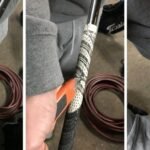Golf spikes help you stay steady while playing. They give you grip on the grass. Twist lock golf spikes are common. But sometimes they get loose. Loose spikes can be a problem.
Why Do Golf Spikes Get Loose?
There are a few reasons:
- Wear and tear from use
- Dirt and debris in the spike lock
- Improper installation
Tools You Need
Before you start fixing, gather these tools:
- Spike wrench
- New spikes (if needed)
- Clean cloth

Credit: mattguides.com
Step-by-Step Guide to Fix Loose Spikes
Step 1: Remove The Loose Spikes
First, take the spike wrench. Use it to remove the loose spike. Turn the wrench counterclockwise. The spike should come out easily. If it does not, try again. Be patient.
Step 2: Clean The Area
Next, use the clean cloth. Wipe the area where the spike was. Remove any dirt or debris. This will help the new spike fit better.
Step 3: Check The Old Spike
Look at the old spike. Is it worn out? If yes, replace it with a new one. If it looks fine, you can use it again.
Step 4: Install The Spike
Take the spike, old or new. Place it in the hole. Use the spike wrench again. Turn it clockwise this time. Make sure it is tight. Do not over-tighten. It should fit snugly.
Step 5: Test The Spike
After installing, test the spike. Walk around a bit. Is it still loose? If yes, repeat the steps. Make sure everything is clean and tight.
Tips for Maintaining Your Golf Spikes
Here are some tips:
- Check your spikes regularly
- Clean your shoes after each game
- Replace worn spikes promptly

Credit: mattguides.com
Frequently Asked Questions
How Do You Fix Loose Twist Lock Golf Spikes?
Tighten the spikes with a spike wrench. Turn clockwise to secure.
Why Are My Golf Spikes Always Coming Loose?
Check the threads for wear. Replace if damaged. Use thread locker.
Can I Use Any Tool To Tighten Golf Spikes?
Use a specific spike wrench. It fits twist lock spikes best.
How Often Should I Check My Golf Spikes?
Check spikes every 3-4 rounds. Tighten if necessary.
Conclusion
Fixing loose twist lock golf spikes is easy. Just follow the steps. Use the right tools. Keep your shoes clean. This will help you play better golf.









Leave a Reply